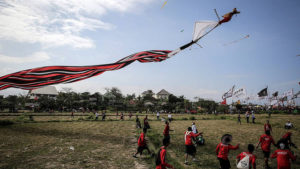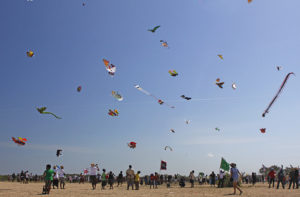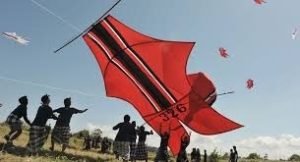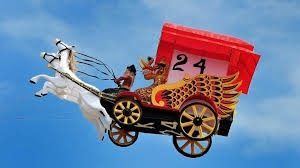Riding The Trade Winds: The Delicate Art Of Flying A Kite In Bali
Original article was published on beBEE by Paul Walters
Paul v Walters is the best selling author of several novels. When he is not cocooned in sloth and procrastination in his house in Bali he also scribbles for several international travel and vox pop journals.
In early July in the tropics the trade winds arrive exactly on cue and blow steadily from east to west until the end of September. One day it is completely still and the next the breezes suddenly spring up;
These winds are the prevailing pattern of easterly surface winds found only in the tropics The trade winds blow predominantly from the northeast in the Northern Hemisphere and from the southeast in the Southern Hemisphere, strengthening during the winter and when the Arctic oscillation is in its warm phase. The term trade winds derives from the Middle English word “trade’ meaning path or track and it was the early Portuguese mariners who first took advantage of them to get to the east where riches awaited.

When the winds begin to blow, size really does matter in Bali for you see the Balinese are crazy about kites and, the bigger the better is the accepted mantra. Kite creations and kite flying is serious business all across the island which results in colossal handmade flying machines that can take up to thirty men and boys just to get them off the ground.
For the Balinese, July and the trade winds mean it’s the time to earn respect, prestige at the annual competition and hopefully bring home prizes to their villages and to show off their latest designs and flying techniques.
A fashion parade it is not.

It is a deadly serious occasion with the reputations of entire Banjars (neighborhood associations) literally hanging on the strings that keep their creations aloft. These are no ordinary kites as some of the monsters can be up to ten meters long by four meters across and takes a small army to prepare and launch them into the sky.
Legend has it that kite flying began when cow herders, some two centuries ago built and flew kites to ward off the boredom of watching over the herd during the day. Over time, simple kite flying evolved into a competitive ‘game’ between herders that has now grown into an obsession that consumes and unites villagers right across the island.
Serious? You bet it is!

Mr. Tambon, Bali’s eminent kite maker and judge at the annual festival was unavailable for an interview for this piece because… he was out flying a kite!
But Wayan, his off – sider and trusty kite salesman was happy to talk to me and take me through the intricate business of preparing a kite for the festival at the end of July.
There are three basic shapes that you will see hovering above Sanur’s beaches and across the Denpasar skies.
The Bebean is perhaps the most common, and resembles a fish with huge twin tails. These are the easiest kites to launch, flying as they do, in even the lightest of breezes. They can sail to great heights as their shape makes them stable even in the strongest of winds. Their distinctive black, white and red colors are easy to spot amongst the other kites, which festoon the sky.
The more intrepid fliers will opt for the Pecukan that may look beautiful, with its twin tails and bright colours but is notoriously difficult to fly and requires enormous skill to control.
Finally there is the Jangaan, (my favorite) with a colorful tail that can sometimes stretch twenty or even thirty meters or more from the base of the actual structure itself.

It is a brave Banjar that will go for style, colour and an impressive tail over the reliable Bebean design, which over the years has become the tried and true kite in the festival.
Once annual competition begins, the judges show no mercy, for, woe betide a team that allows any part of the kite to touch the ground on landing, as this leads to instant disqualification
To prevent this, large sections of the entourage who risk flying the Jangaan are assigned to catch the tail on landing.
During practice I witnessed members of the team (some 50 or 60 strong) sprinting wildly across the sand and the adjoining rice fields, diving over each other to ensure that not an inch of the beast touched the earth.
Sometimes a beautiful mistress is hard to control!
Competition is fierce; pitting Banjar against Banjar for the status of taking home the trophy that will bring a year’s worth of bragging rights for the winning team.

Once the festival begins, the village’s gamelan orchestra accompanies the team and will bash frenetically during competition driving the participants on to greater “heights.”
The festival is an incredibly noisy and chaotic day with a cacophony of sound and hundreds of team members dashing hither and thither, heads up watching the sky and often colliding with other team members, food carts, spectators and even competition organizers who often have to make a mad dash for cover.
Crowds will surround the ‘battlefield’ reveling in their Banjars’ success or another’s failure but all in the Balinese spirit of giving.
For the more intrepid of the Banjars who break with tradition will enter the fourth category, the Kreasi Baru or new creation, where basically anything goes as long as it gets up to the required height.
Designs range from ancient sailing ships to temple replicas that somehow defy aeronautical practices with design triumphing over the construction’s quest to get off the ground and into the air.

Points are earned for innovation, design and the ability to stay aloft!
It all reaches fever pitch on windswept Padang Galak beach in Sanur, which plays host to the Bali Kite Festival (13-15 July). Now in its 34th year this festival attracts over 1,200 kites in competition and up to 10,000 spectators. Whether it’s airborne art or sheer indulgence, these Balinese kites are a sight to behold.
It’s crowded, colorful, chaotic and loud and one of those events that will be remembered for years to come.
So if any bees happen to get down here during July, don’t miss it!

About the Author
Paul v Walters is the best selling author of several novels. When he is not cocooned in sloth and procrastination in his house in Bali he also scribbles for several international travel and vox pop journals.